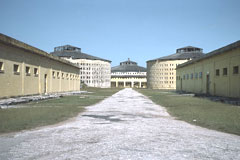|
MODEL PRISON (PRESIDIO MODELO)
 The Cuban President of the period (1925) wanted to establish in the Isle of Pines (the present day Isle of Youth) a prison similar to the one in Illinois, United States of America, and that is how it came into being.
Soon the prison became a place where the most unheard of forced labour was carried out among the penal population, victims of many murders for decades. In 1933 there were over 578 detainees for common crimes that had been murdered, while their families were told that the deaths were suicides.
In October of 1953, a group of attackers of the Moncada Garrison (Cuartel Moncada, Santiago de Cuba, July 26th of that year), led by Dr. Fidel Castro and his young brother Raúl, were imprisoned there, until May 15th of 1955, when President Batista was forced to pardon them due to the strong public protest. The wealth of history within its walls that have been hailed as a National Museum attracts many visitors.
The Cuban President of the period (1925) wanted to establish in the Isle of Pines (the present day Isle of Youth) a prison similar to the one in Illinois, United States of America, and that is how it came into being.
Soon the prison became a place where the most unheard of forced labour was carried out among the penal population, victims of many murders for decades. In 1933 there were over 578 detainees for common crimes that had been murdered, while their families were told that the deaths were suicides.
In October of 1953, a group of attackers of the Moncada Garrison (Cuartel Moncada, Santiago de Cuba, July 26th of that year), led by Dr. Fidel Castro and his young brother Raúl, were imprisoned there, until May 15th of 1955, when President Batista was forced to pardon them due to the strong public protest. The wealth of history within its walls that have been hailed as a National Museum attracts many visitors.
For more information:
www.cuba-history.com
,
www.cuba-isladelajuventud.com
|